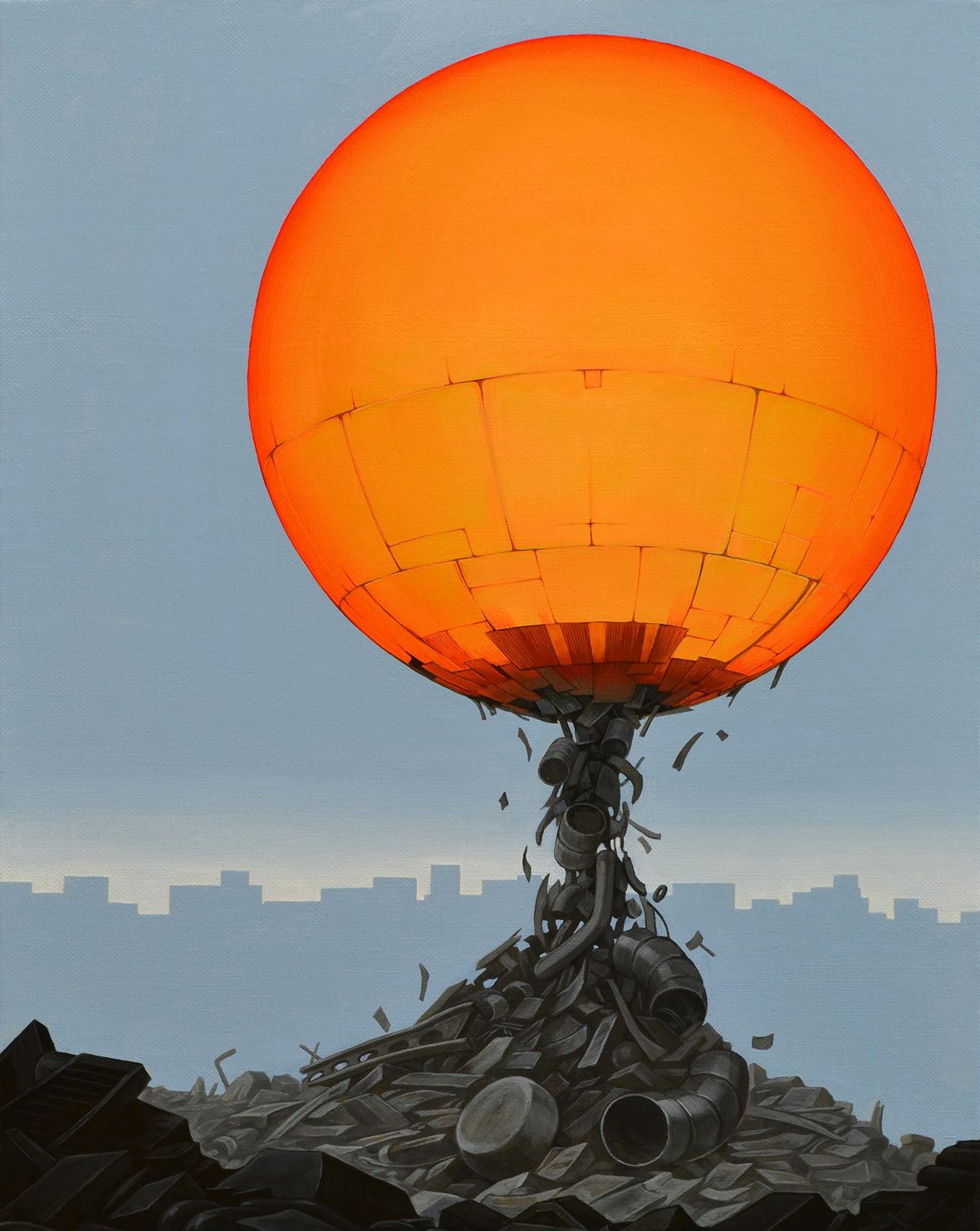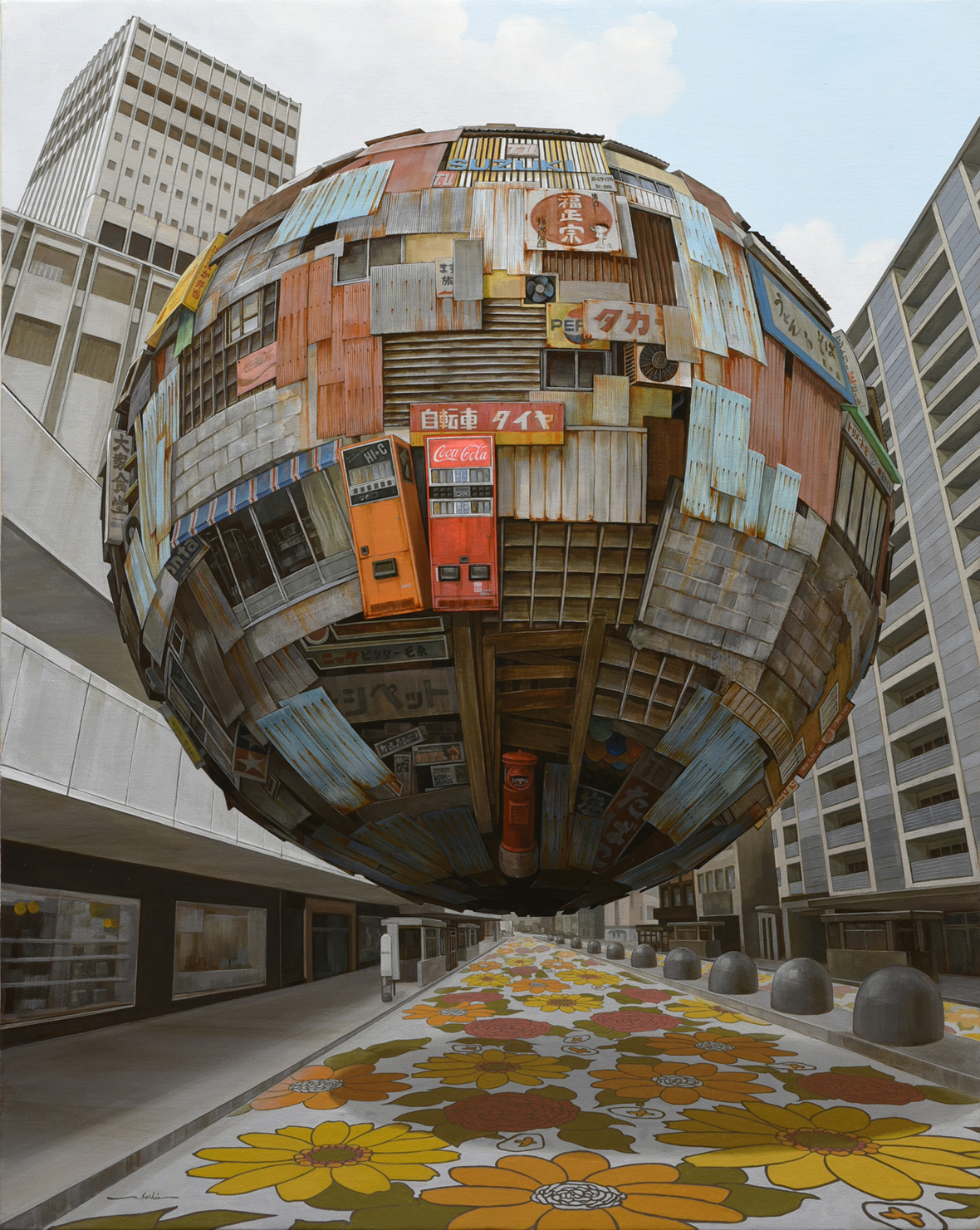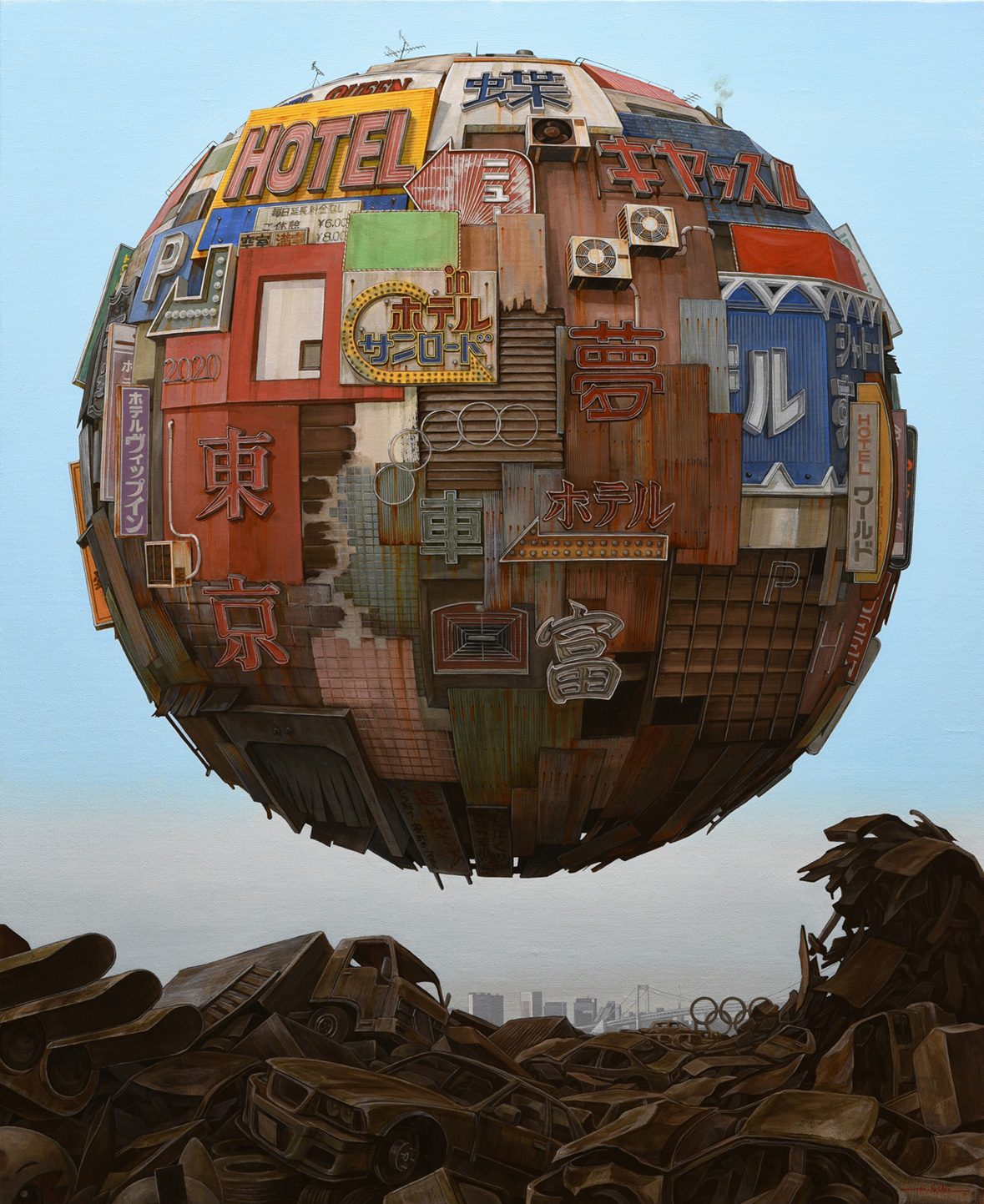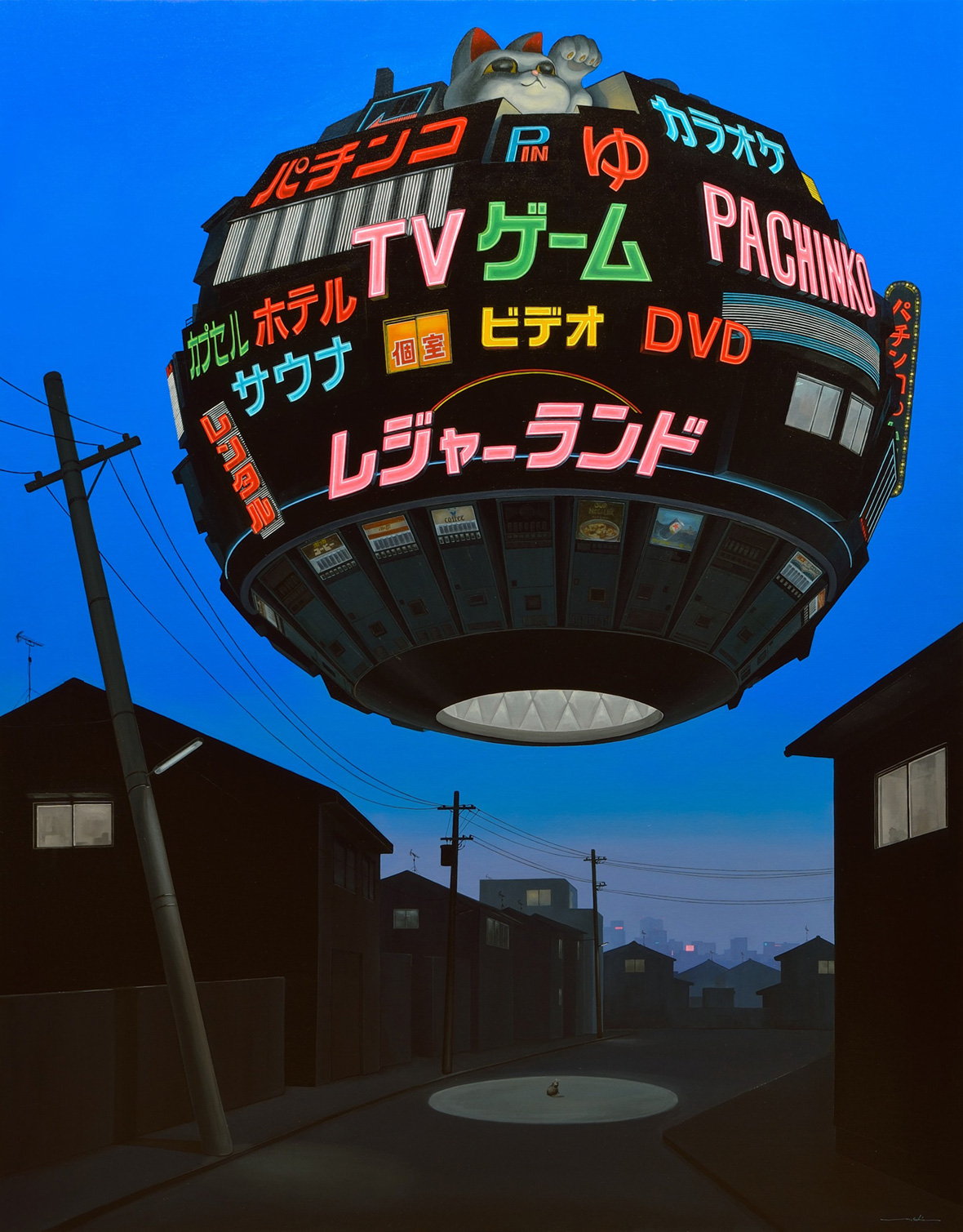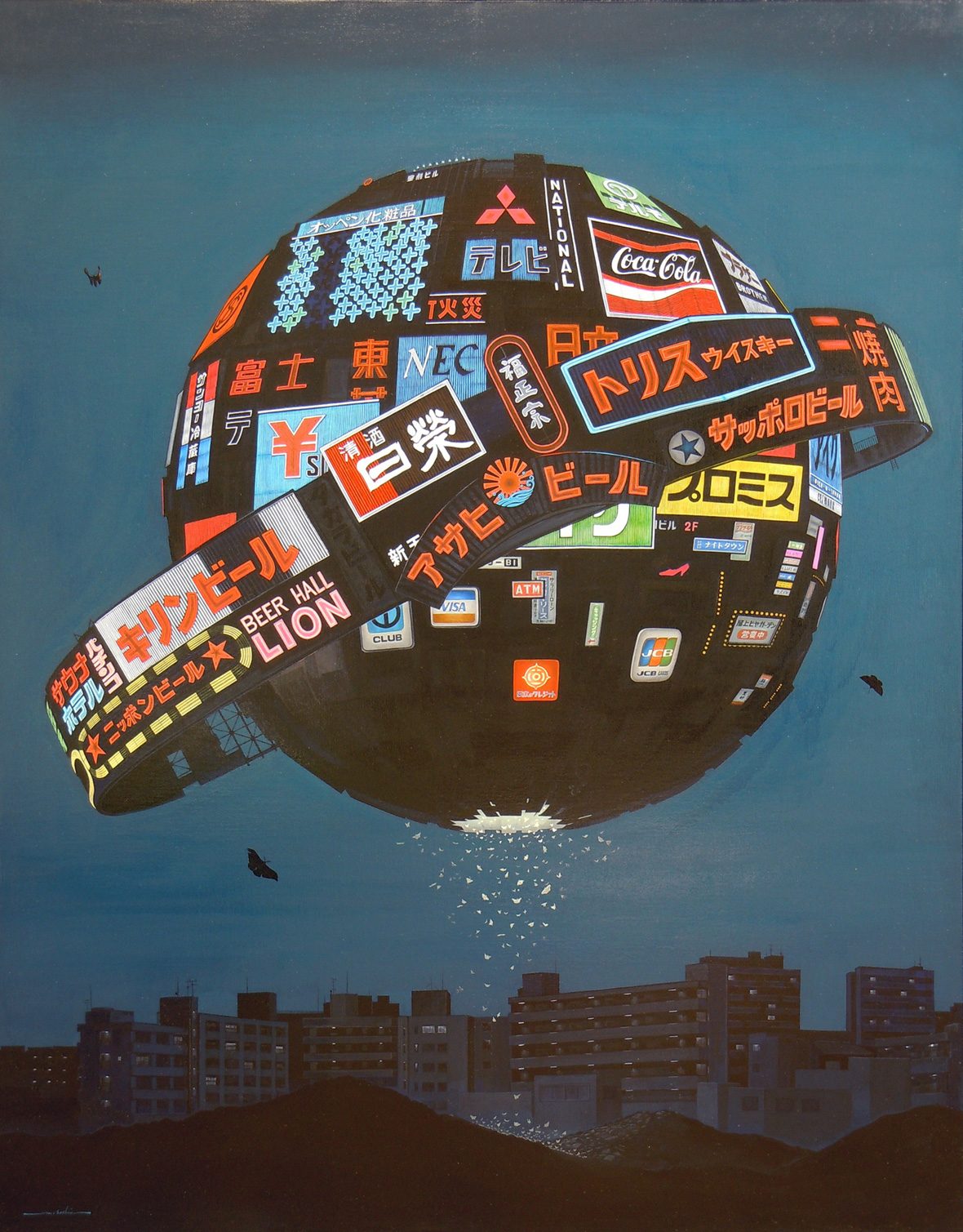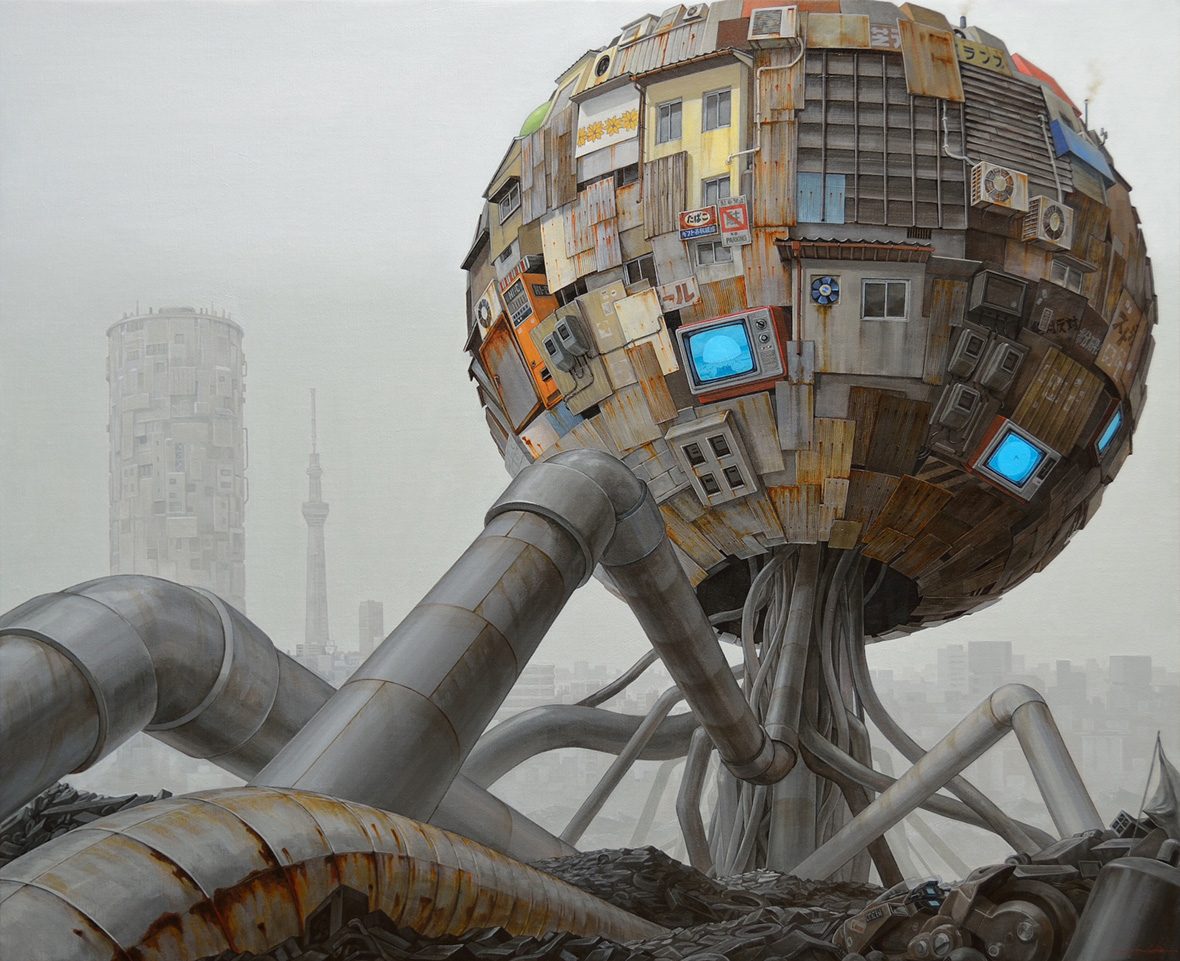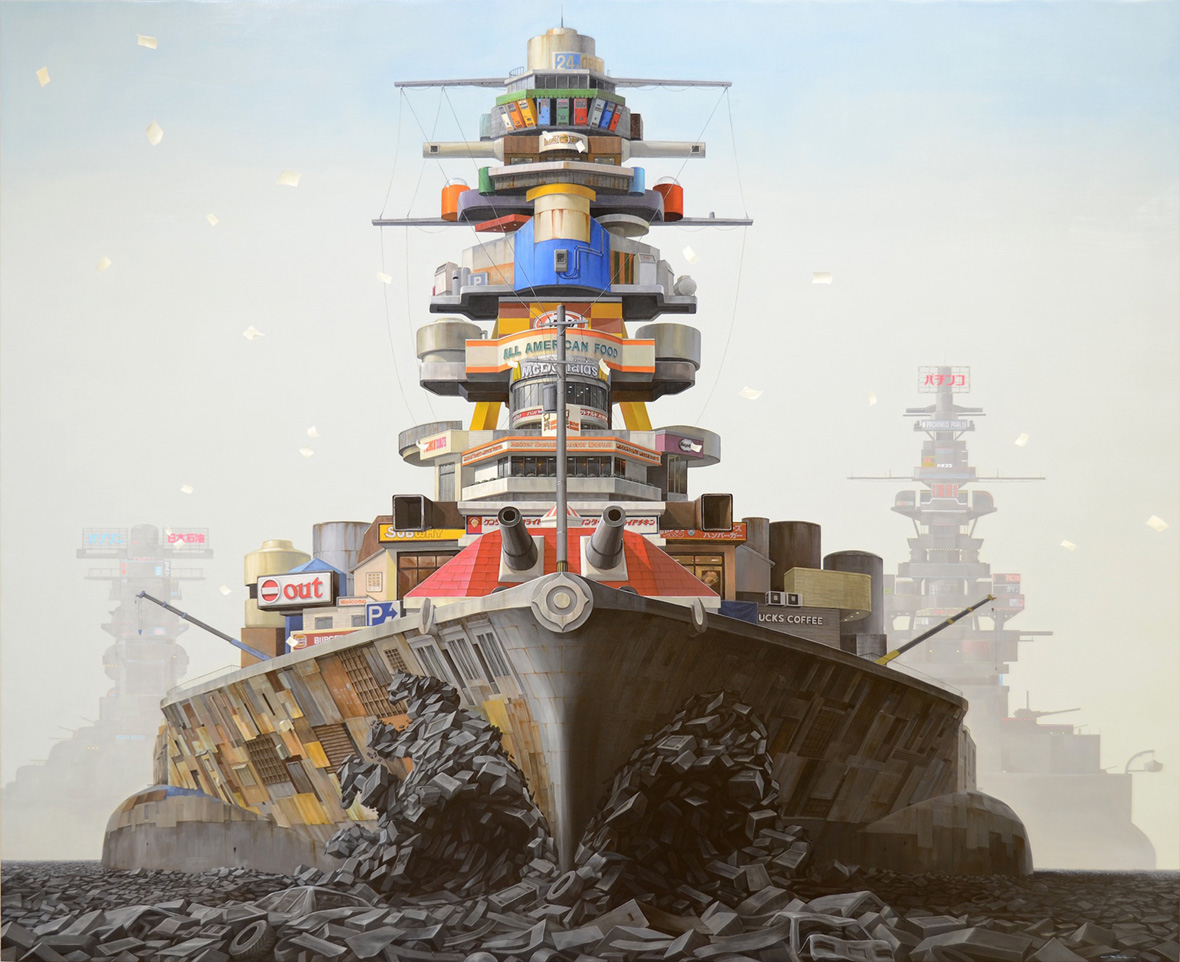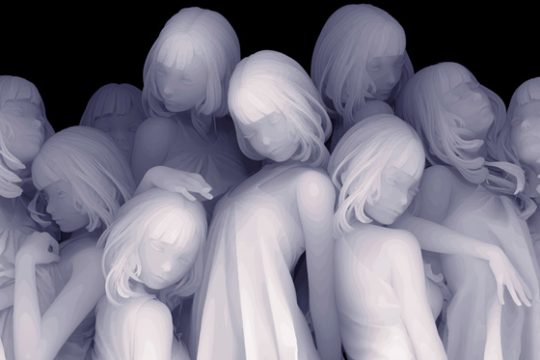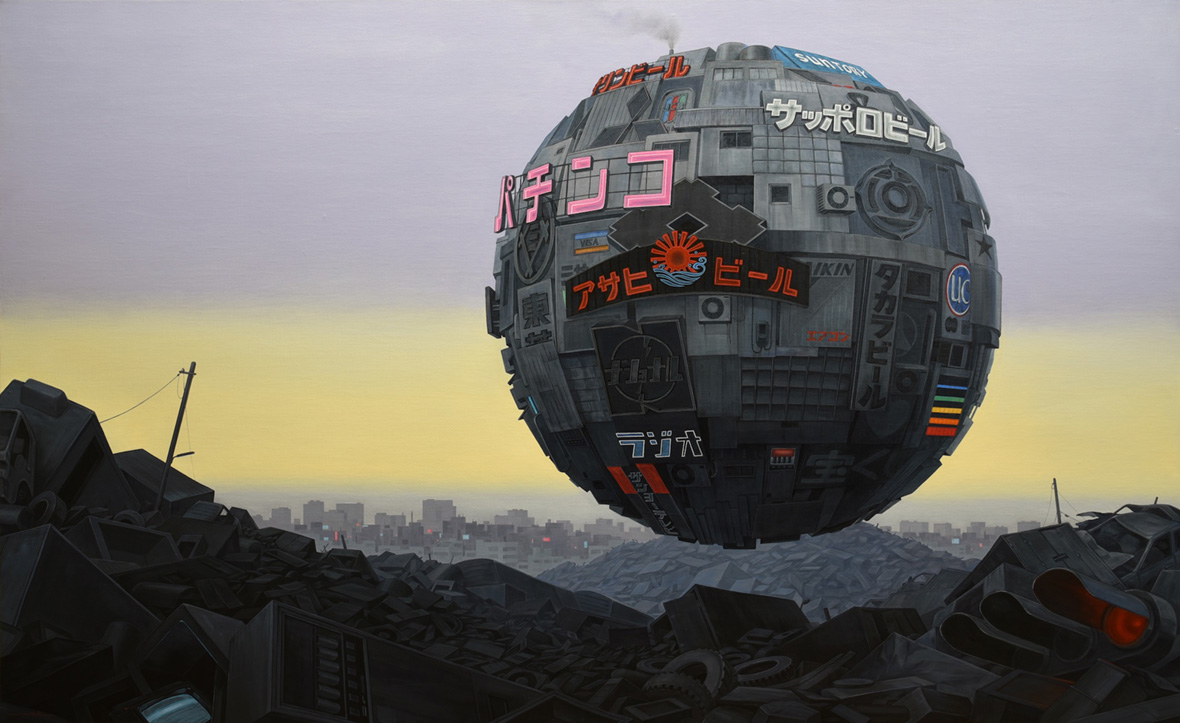
Behemothian orbs hovering above landfills are more than a recurrent sight in the works of Japanese artist Masakatsu Sashie; they’re the singular subject matter of his art. Since 1996, he has shown these mysterious spheres in countless paintings and sculptures. Its symbolism, however, remains the same, rooted in concepts of havoc and time. “The orbs represent humanity—they represent us,” he says.
悬浮于垃圾填埋场上空的巨型球体是日本艺术家 Masakatsu Sashie(指江昌克)作品中最常见的元素;更准确地说,这是他的艺术作品唯一的主题。从 1996 年以来,他在无数幅绘画和雕塑作品中展示了各式各样的神秘球体,其象征意义也始终如一,讲述地球浩劫与时间变迁的概念。“这些球体代表着人类——也就是我们自己。”他解释道。
The large three-dimensional globes dominate his paintings, an intrusive object that feels utterly out of place. They’re assemblages of man-made components, such as televisions, vending machines, and advertising signs, elements that appear old and unsightly, unwanted trash that belong in landfills absorbed by some sort of otherworldly energy to form the orb.
巨型的三维球体占据大部分的画面,像是贸然闯入的异次元物体,有种格格不入的感觉。这些球体由各种破旧的人造零部件组成,如电视机、自动售货机和广告招牌,仿佛是垃圾填埋场的废物被某种奇异的力量吸聚在一起,从而形成这个巨型的球体。
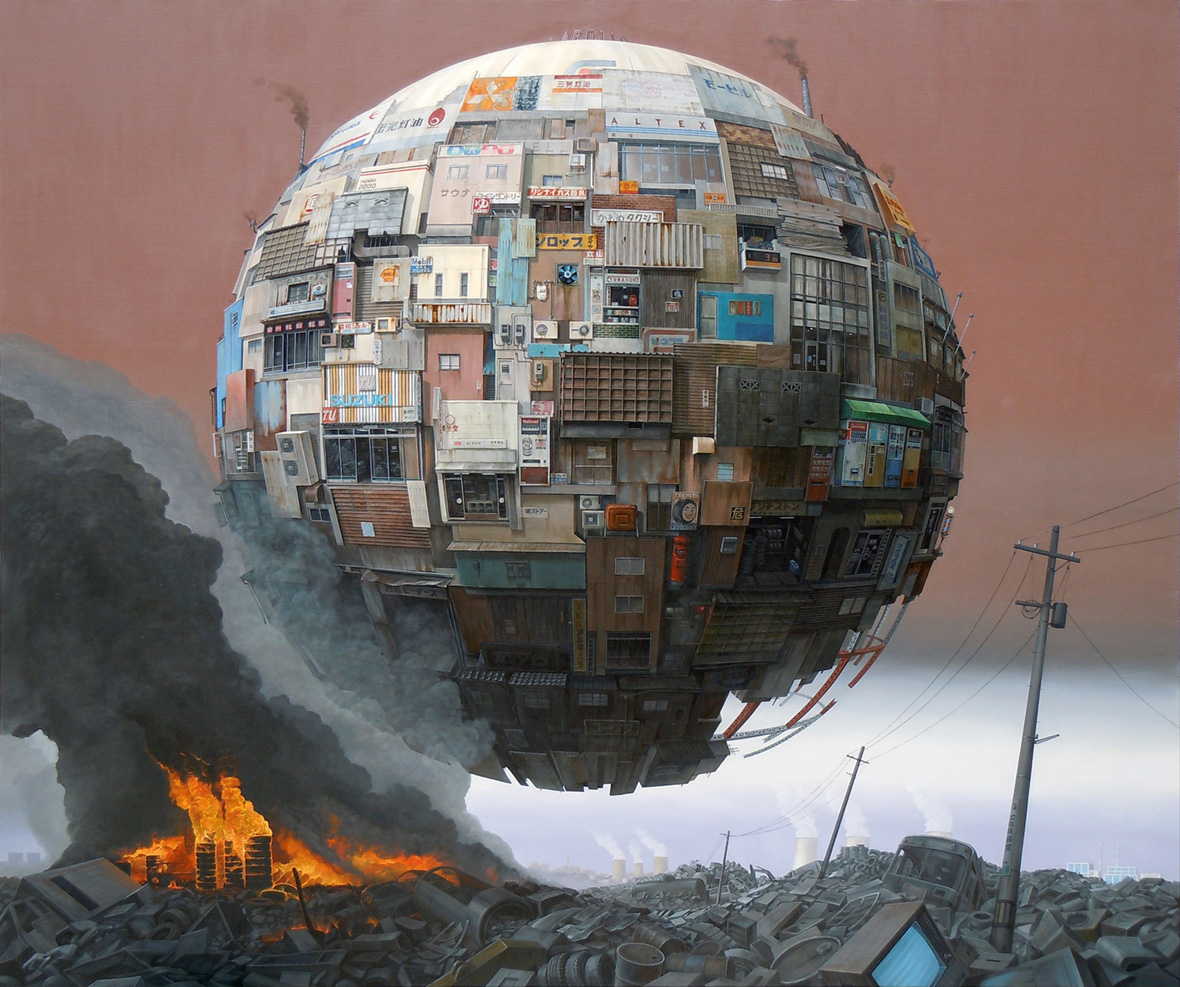

In the background, under polluted skies, a gloomy Tokyo skyline is often present, recognizable by iconic landmarks such as the Tokyo Tower and the Sky Tree. There’s a conspicuous absence of natural elements in his paintings. Not even Mount Fuji, commonly seen in depictions of Tokyo’s skyline, makes an appearance.
画面的背景通常是灰暗的天空与东京城市天际线,可以看到东京的地标建筑,如东京塔和天空树。在他的绘画中完全没有一点自然的元素,甚至也看不到东京标志性的富士山的踪影。
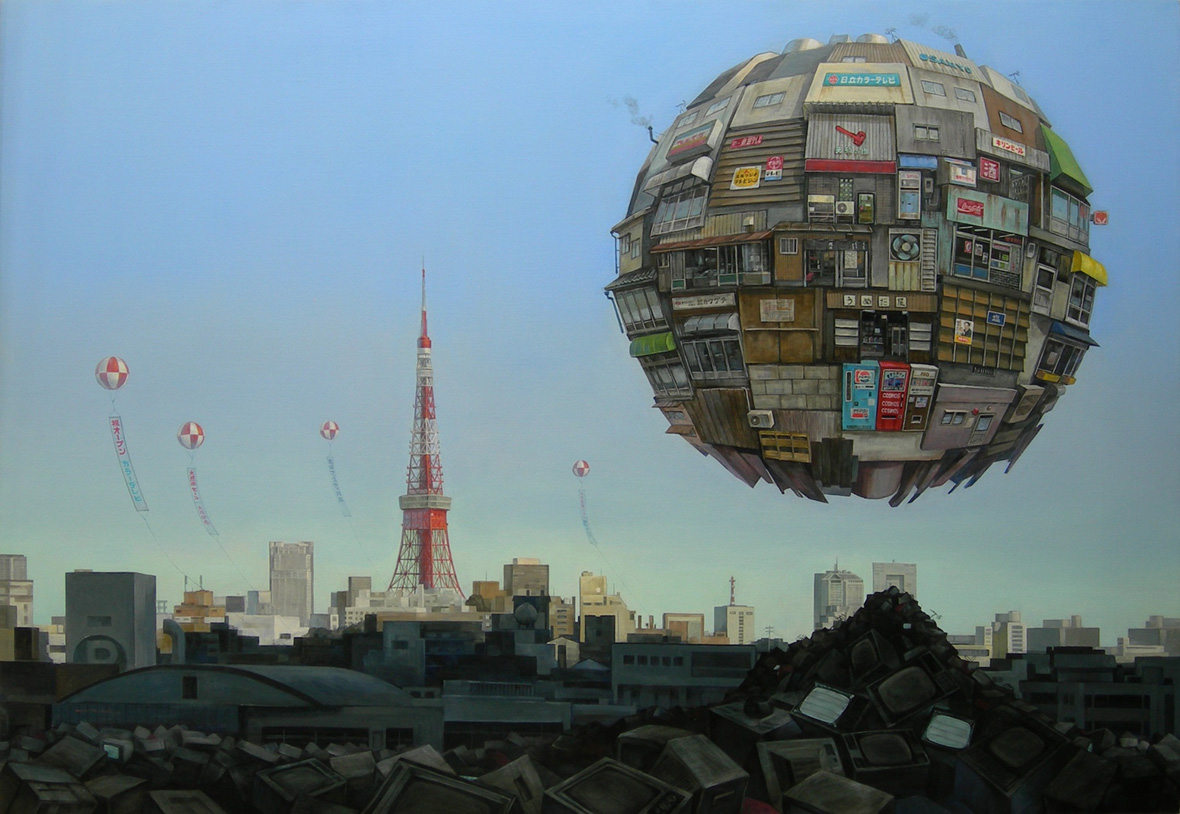
Only in rare instances are organic life forms shown in his works, such as a lone mouse gazing up at the ominous globe hovering overhead. Still, there’s a constant allusion to human existence just outside of the frame—the rubbish and debris of his work, seemingly a critique of modern consumption habits and wasteful practices.
只有在极少数情况下,才会在他的作品中看到生命体,譬如一只老鼠正在眺望悬浮球体。尽管如此,你仍能从他的画面中,看到对于人类的暗示——各种垃圾和废墟,似乎是在批判现代社会的消费习惯和铺张浪费。
The concept of time is another prevalent theme in Sashie’s art. “The landfills are full of man-made objects, representing the accumulation of time,” he says. The notion of time is also expressed by the juxtaposition between dated objects, alluding to the past and the city’s modern skyline, indicating the present, while the post-apocalyptic settings seem to be his prophecies of the future.
时间概念是 Masakatsu 作品的另一个常见主题。“垃圾填埋场里充斥着各种人造物品,寓意着时间的累积。”他说道。此外,过时的物体与现代化的城市天际线并列在一起,暗指过去与现在,而世界末日般的环境仿佛是他对于人类未来的预言。
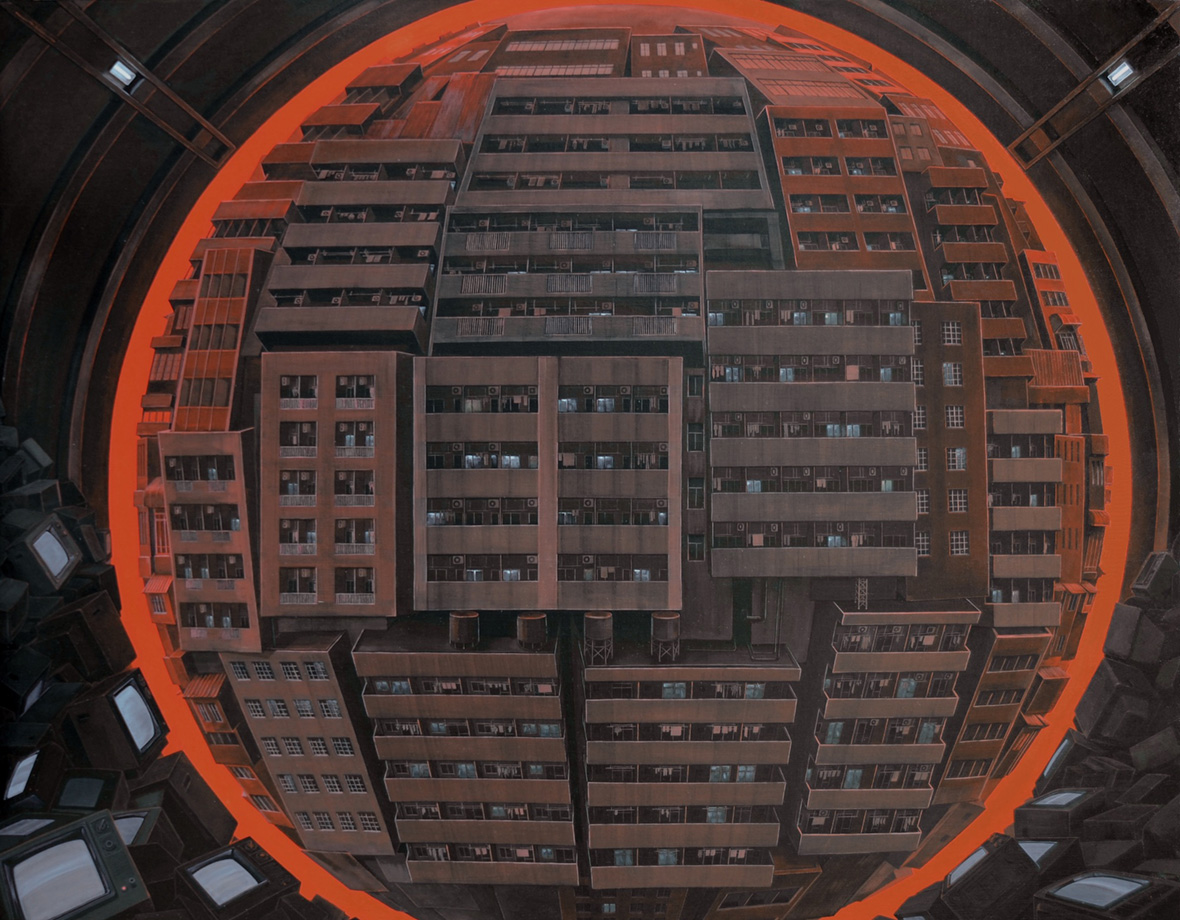
Sashie often includes logos of Japanese and American corporations in his paintings. Notably, in one of his few pictures without an orb, Sashie depicts a fleet of warships that—similar to his planet-like orbs—mash together familiar signs and structures, but instead of trash, American fast-food chains, such as McDonald’s and Starbucks, have been melded together. The fleet maneuvers through a sea of waste, flying the flag of global consumerism, as if on its way to conquer other lands.
Masakatsu 经常在画中描绘一些日本和美国企业的标志。值得注意的是,在他为数不多没有球体的作品中,Masakatsu 描绘了一支战舰队伍,将各种人们熟悉的品牌标志和招牌糅合在一起,包括美国快餐连锁品牌,如麦当劳和星巴克。这支舰队带着全球消费主义的旗帜,飞过一片垃圾的海洋,仿佛正要前往征服其他地域。
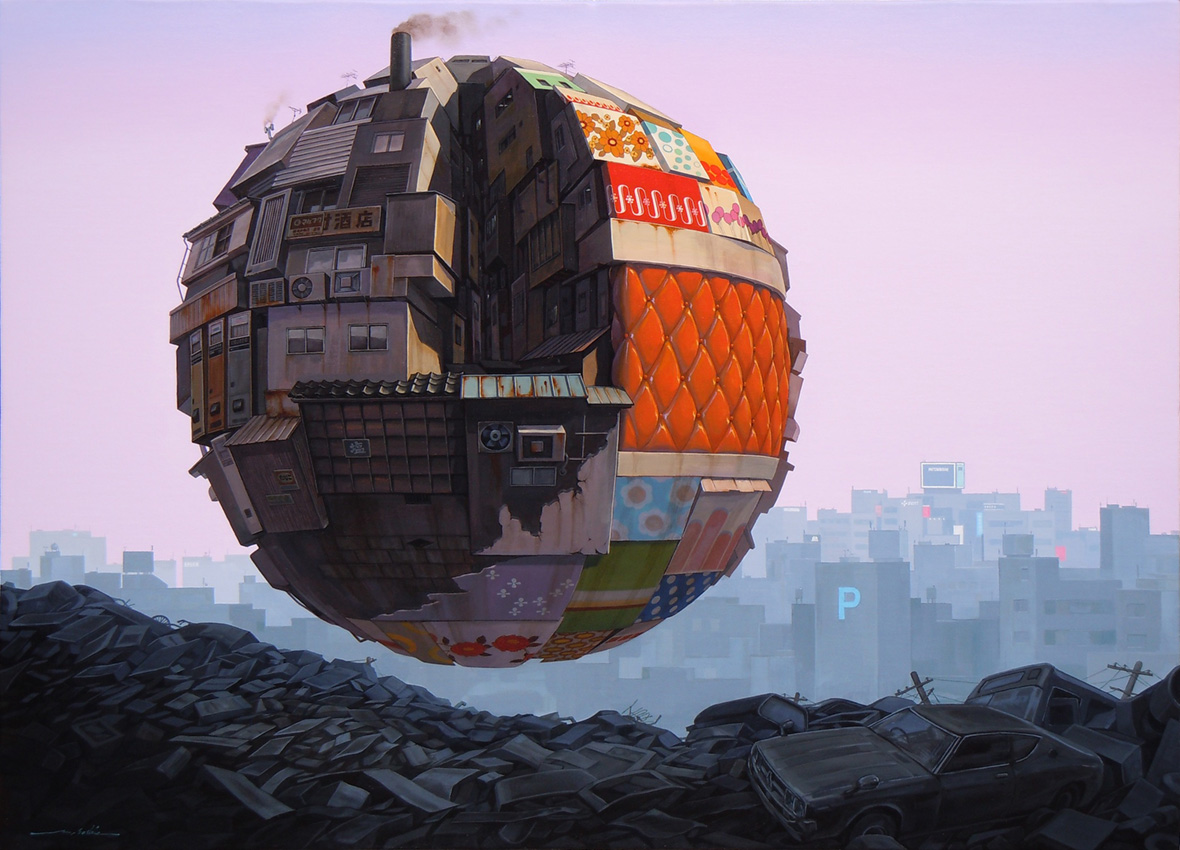
His musings on humanity and time started in his hometown, Kanazawa. “Kanazawa is like a miniature garden, where the obsolete and the modern coexist,” he says. “Because of its distance from other urban centers, there’s a sense of isolation that allowed me to consider the tide of times.” Sashie was also drawn to the art of bonsai and dioramas from a young age and, today, his art appears as his own miniature world of sorts. “I start my creations by making a story; it’s like creating a world.”
Sashie asserts that his works are impartial, in that they’re neither negative nor positive outlooks. But the paintings speak for themselves, and like crystal balls, his orbs give a glimpse of a possible future, however frightening it may be, warning us of the risks of rampant consumerism and neglectful waste. “I’m glad if my works serve as a clue for the viewer to start thinking about how they see the future,” he says.
他对人性和时间的思考源于他的家乡金泽(Kanazawa)。他说:“金泽就像一个微型花园,一个过去和现代共存的地方。因为远离城市,这种隔离感让我能够好好思考时代的变迁。”此外,Masakatsu 从小就对艺术盆景和立体模型很感兴趣,他的艺术作品仿佛是他自己打造的一个微型世界。“我在创作前会先想好一个故事,就像是在创造一个世界。”
Masakatsu 坚称自己的作品代表中性的立场,对未来的展望既非悲观也不是乐观。但是这些画作的意思不言而喻,就像魔法水晶球一样,他的球体让观众瞥见了一个可怕的未来,警告着人们肆无忌惮的消费主义和铺张浪费所带来的危险。“如果我的作品能让观众开始思考未来,我也挺高兴的。”他说道。
Like our stories? Follow us on Facebook and Instagram.
Website: www.sal-s.com
Instagram: @masakatsusashie
Facebook: ~/SashieMasakatsu
Contributors: Tomas Pinheiro, Lucas Tinoco
Chinese Translation: Olivia Li
网站: www.sal-s.com
Instagram: @masakatsusashie
Facebook: ~/SashieMasakatsu
供稿人: Tomas Pinheiro, Lucas Tinoco
英译中: Olivia Li

